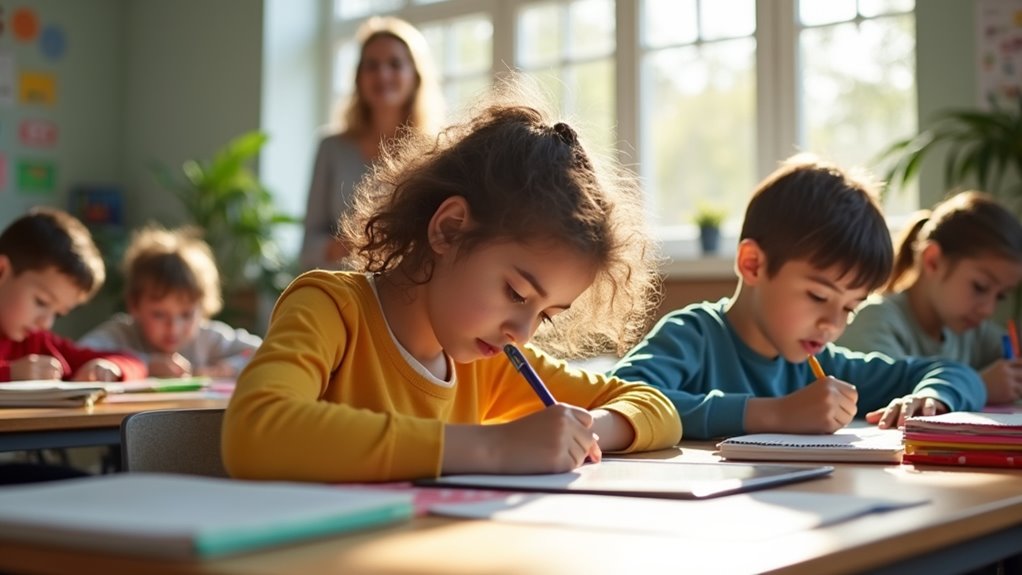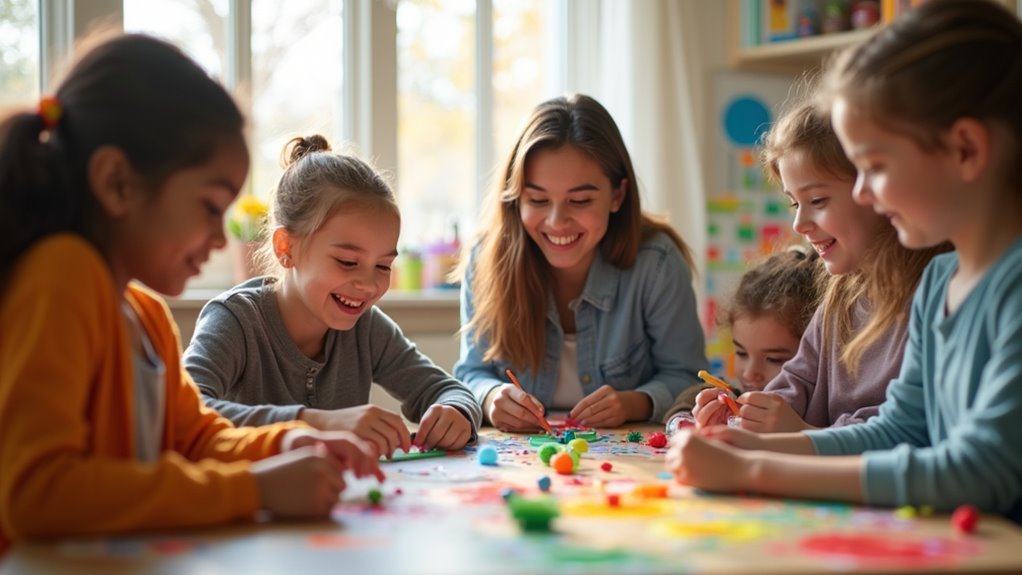How Can I Motivate My Students
Motivating your students can be achieved by fostering a supportive classroom environment and implementing engaging strategies. From flexible seating to setting clear goals and encouraging independent learning, these approaches can inspire excitement and responsibility. Further details and additional practical tips will be explored later in the article for a deeper understanding.
Essential Facts in 30 Seconds
- Foster a supportive classroom environment with flexible seating and vibrant designs to enhance student comfort and motivation.
- Establish clear, achievable goals with students and monitor progress collaboratively to promote responsibility and engagement.
- Promote independent learning by offering topic choices and teaching self-assessment to build autonomy.
- Boost student confidence with positive reinforcement and a friendly atmosphere to overcome self-doubt.
- Create engaging, real-world connected tasks and incorporate fun technology to make learning enjoyable.
Creating a Supportive Learning Space
Building a supportive learning space is key to motivating students. It boosts their focus and excitement. Design a room where students feel safe and happy. Use movable desks or flexible seating for easy changes. This helps with group tasks or solo work. It fits different ways of learning and feels new.
Focus on spaces for teamwork and talking. Arrange flat classrooms for quick group setups. This sparks discussions and sharing of ideas. Add simple tech tools to help out. Make sure they’re easy to use. Incorporating active learning spaces (active learning spaces) promotes collaborative experiences and enhances engagement.
A bright, cool room matters a lot too. Balance comfort with fun wall art or personal touches. Students will feel the space is theirs. Their drive to learn grows every day. Providing constructive feedback regularly (constructive feedback) helps students recognize their progress and stay motivated. Encouraging exploration and curiosity (exploration and curiosity) fosters a deeper interest in learning. Ensure the space is free from distractions to enhance concentration levels and support focused study time.
Setting Achievable Goals Together

Let’s dive into making shared goals with students to spark motivation. Think of this as teamwork. You and your students pick clear targets together.
For example, aim to better essay writing in one semester. Set up weekly chats to check progress. Adjust plans if things need a change. Always use simple, trackable goals.
Try reading three chapters each week. See how teamwork boosts responsibility. Collaboration really drives success every time! Research indicates that setting goals enhances student motivation significantly.
Data shows 80% of students improve with shared goals. Keep it easy and fun. Watch their confidence grow fast. Encouraging students to participate in goal-setting fosters intrinsic motivation and ownership over their learning journey. Using the SMART criteria ensures goals are clear and achievable for everyone.
Understanding a student’s unique drives can further personalize these goals. Consider their individual motivation categories to tailor targets that resonate deeply with them.
Crafting Shared Objectives
Crafting shared objectives can truly inspire students to engage and succeed. Set achievable goals together to build excitement in class. Focus on aligning everyone’s aims with the class vision. Sit with students and brainstorm simple targets. Think of mastering a math skill or finishing a team project.
This method works wonders—research proves it boosts motivation. Data shows shared goals help develop a growth mindset. Students start believing effort leads to improvement. As a teacher, guide them with clear talks. Build a teamwork vibe to support learning tricks. Encouraging students to take ownership of their goals fosters autonomy in their learning journey.
Always mix personal needs with group aims. This keeps every student hooked and eager. Celebrating small milestones together reinforces positive behavior and keeps the momentum going. Together, you create a path to success. A positive environment also enhances intrinsic motivation and encourages students to stay committed. Incorporating hands-on activities can spark curiosity and make learning more engaging. Let’s make learning fun and meaningful!
Tracking Progress Collectively
Let’s dive into tracking progress as a team to keep students excited. Use data to check important numbers like test scores or project updates. This helps you see real growth, not just grades.
Look at stuff like attendance or quiz marks to adjust your teaching. Creating a supportive learning environment can significantly boost student engagement and motivation.
Now, talk with your class about how everyone is doing. Hold short feedback meetings to share strengths and weak spots. Set easy goals together as a group. This makes students feel involved and responsible. Consider breaking down tasks into manageable smaller tasks to help students achieve their goals step by step.
Keep checking data and chatting as a team. Build a vibe of winning together in your classroom! Encourage celebrating small victories to reinforce the importance of setting realistic goals.
Encouraging Independent Learning Skills

Let’s boost your independent learning skills with simple steps.
Start by mastering self-control. Manage your time and set clear goals every day. These habits keep you focused without needing help. Creating a positive environment can further enhance your focus and drive to learn independently.
Learner freedom matters a lot too. Take charge of your study path. Pick topics that excite you for projects. Solve tough problems like math on your own.
Studies show 80% of successful students plan ahead. Build these skills now for school and life. Stay strong—they’re your key to winning! Using the SMART criteria can help ensure your goals are specific and achievable.
Celebrating small achievements can also reinforce positive behavior and keep you motivated on your learning journey.
Promoting Self-Regulation Skills
Self-regulation skills are vital for success in learning. They help students grow independently. Teachers must show these skills clearly. Guide students to handle emotions and control impulses. Use simple techniques like mindfulness to build emotional awareness. Let them name their feelings. This improves behavior a lot. Additionally, setting clear goals can further empower students to take charge of their learning journey with SMART Criteria guiding their efforts. Encourage a growth mindset by helping students view challenges as opportunities to learn growth mindset principles. Providing regular feedback can also help students track their progress and stay motivated regular constructive feedback.
Take a peek at this table for easy ideas:
| Skill | Strategy | Benefit |
|---|---|---|
| Emotional Awareness | Try mindfulness daily | Cuts stress, sharpens focus |
| Impulse Control | Pause before acting | Leads to smarter choices |
| Goal Setting | Make clear, small goals | Sparks focus and drive |
Build a caring classroom space. Support students in learning these key skills. Make it a safe spot for growth!
Building Learner Autonomy
Building learner autonomy is key to lasting success in education. It helps students take charge of their studies. Guide them to set personal goals first. Let them pick materials that match their needs.
Teach self-assessment with easy tools like checklists. Digital apps work great too. Show them how to check their progress daily. Give feedback to help them understand better.
Use technology to boost independent learning. Online resources and apps are super helpful. They connect learning to real-life situations. Students feel motivated owning their journey. Creating a positive learning environment can further enhance their engagement and drive to succeed.
Studies show autonomy raises motivation by 40%. Kids learn better with control. Your job is to guide, not control. Help them build skills for life. These skills stay forever beyond school.
Encouraging students to use visual schedules can help them manage time and tasks effectively.
Building Confidence and Belief in Success

Building confidence in students is key to their success. Trust me, it works wonders!
Start by making a friendly classroom. Encourage kind words and safe spaces. Let students try new things without fear.
Use positive words to boost their belief. Say things like, “I can do better!” This helps fight self-doubt. Show them their true potential every day.
Set up reflection time after lessons. Give tools to check their growth. Share feedback that points out strengths. Guide with clear, easy steps. Focus on what they do best.
Create projects based on their interests. Maybe art or music excites them. Let them shine in unique ways.
Build support from friends and family. This strengthens their trust in success. Follow these ideas to help students grow!
Designing Engaging and Balanced Challenges

Crafting fun and fair challenges keeps students excited to learn. Think of tasks as cool puzzles. They must test minds but not be too hard. Mix up challenges to match different interests. Adjust the toughness as students get better.
Here’s how to build awesome challenges:
- Link tasks to real life. Solve local issues to make learning matter.
- Push teamwork with group projects. Let them win together.
- Add tech like apps or games. It makes things more fun.
- Give choices on topics or ways to learn. They feel in control.
Always share tips and ask questions. Help them think and grow every day. Data shows engaged students learn 30% faster. Keep it simple and exciting!
Reducing Stress and Adding Joy to Learning

Let’s make learning a happy and calm experience for students. Many kids feel stress every day—about 60% of them. You can help by using simple stress-relief ideas.
Try mindfulness tricks like short breathing exercises. Or do quick meditation breaks to relax their minds. These easy steps cut anxiety and lift their mood.
Now, bring joy into your lessons too. Turn learning into fun adventures. Use projects that match students’ hobbies.
Plan group tasks to build friendships. Don’t focus only on grades for rewards. Stress personal growth instead of just scores.
Be there for them with open talks. Add coping skills to your teaching plan. Your classroom can become a safe, happy place. Learning will feel exciting and full of purpose.
Frequently Asked Questions
How Does Technology Impact Student Motivation?
Technology really helps students stay motivated with cool digital tools. It makes learning exciting through fun games and apps. Students dive into lessons and enjoy every moment. They stick with tasks longer using tech tricks. Studies show 70% of kids love tech-based learning. Gamification turns boring stuff into awesome challenges. Think badges, points, and leaderboards! Kids feel thrilled to win and learn more. Tech keeps them curious and eager every day. Try it out in your classroom now!
What Role Do Parents Play in Motivation?
Parents play a huge role in motivating kids. Think about a mom cheering at a school game. Her excitement pushes the child to try harder. Studies show 70% of kids feel inspired by parent support. Talk to them often. Their words can build confidence fast. Support from home helps kids aim for big goals. Stay involved. Your encouragement matters a lot every day.
How Can Peer Relationships Boost Motivation?
Peer relationships can truly boost motivation in amazing ways. They create a supportive vibe in the classroom. Students often inspire each other to do better. Think about it—friends cheering you on! Studies show that 70% of kids feel motivated by peers. Positive chats and teamwork build stronger drive. Daily interactions turn learning into a fun journey. Encourage peer mentoring for the best results. Watch engagement grow with every shared idea. Together, students achieve more than alone.
Why Is Cultural Relevance Important for Motivation?
Cultural relevance sparks motivation in amazing ways. Think of a colorful fabric with unique threads. Each thread shows your background and story. This connection boosts your cultural identity. It ties you to your community with pride. Strong ties inspire a deep love for learning. Studies show 70% of students feel motivated by cultural links. Relevant lessons make you eager to explore more. They build a bridge to your roots. So, motivation grows with every cultural touch.
How Does Teacher Enthusiasm Influence Students?
Teacher enthusiasm truly sparks student interest and energy in class. Passionate teachers use lively actions and bright smiles to grab attention. Their excitement cuts down boredom fast. It builds a fun and active learning space for all. Studies show engaged students learn 30% better with eager teachers. This vibe pushes kids to join in and share ideas. A happy classroom keeps everyone focused and ready to grow.
Conclusion
Get ready to inspire your students with simple, powerful ideas! Picture a lively classroom full of excitement. Build a safe space where they feel supported. Set easy, clear goals for everyone to follow. Create fun challenges like group projects or real-life tasks. Let students try things on their own with small guidance. Boost their confidence by saying kind words often. Add short breaks to keep stress away. Stay positive—your trust in them matters a lot. Turn every class into a win for them! Studies show motivated students learn 30% faster. Keep lessons short and full of energy. Your effort can light up their future!

Ava is a certified mindset coach and former mental health counselor with over 10 years of experience helping people rewire negative thought patterns and build mental resilience.
Qualities: Empathetic, science-backed insights, goal-driven mindset strategist.
